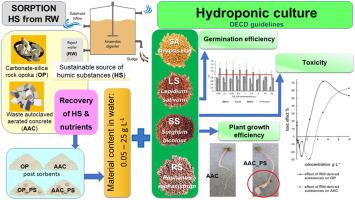从原废水中吸附腐殖质后,基于奥波卡和废弃混凝土的材料的肥料特性。
IF 8.1
2区 环境科学与生态学
Q1 ENVIRONMENTAL SCIENCES
引用次数: 0
摘要
废水处理和回用是缓解水资源短缺和水质下降的一种战略方法。天然有机物,尤其是动植物腐烂产生的腐殖质(HS),往往决定着废水处理后的水质。本研究将腐殖质回收纳入常规废水处理中,与碳捕获和碳存储的全球趋势保持一致。研究评估了奥波卡(OP)和废蒸压加气混凝土(AAC)从实际废水(RW)中吸附 HS 的功效。分析表明,富立酸占 RW 中有机物的 89%。OP 和 AAC 对 HS 的吸附能力为 200 mg g-1。后吸附剂中的金属浓度保持在波兰和欧盟标准规定的肥料管理限制范围内。这些材料在水培系统中以不同剂量(0.05 至 25 克/升)进行了进一步的植物活性测试。植物毒性研究表明,0.1 至 2.5 g L-1 的后吸附剂浓度范围最适合促进大多数受测植物的生长。这项研究强调了使用后吸附剂作为肥料的潜力,通过从垃圾中回收 HS 来促进可持续发展,并支持循环经济方法。本文章由计算机程序翻译,如有差异,请以英文原文为准。

Fertilising properties of materials based on opoka and waste concrete after sorption of humic substances from raw reject water
The treatment and reuse of wastewater in a strategic approach to mitigate water scarcity and its declining quality. Natural organic matter, particularly humic substances (HS) from decomposed plant and animal material, often determined the quality of treated wastewater. This study integrates HS recovery into conventional wastewater treatment, aligning with global trends towards carbon capture and storage. The efficacy of opoka (OP) and waste autoclaved aerated concrete (AAC) to sorb HS from the real reject water (RW) was evaluated. The analysis showed that fulvic acids comprised 89% of the organic matter in RW. OP and AAC demonstrated HS sorption capacities of 200 mg g⁻1. The metal concentrations in the post-sorbents remained within the regulatory limits set for fertilizers by Polish and EU standards. The materials were further tested for phytoactivity in hydroponic systems at different doses (0.05–25 g L−1).A more balanced ratio of ionic forms in the post-sorbents resulted in lower conductivity, improving their chemical stability and phytoactivity. Phytotoxicity studies indicated a that a concentration range of post-sorbents from 0.1 to 2.5 g L−1 was optimal for promoting the growth of most of the tested plants.
This research highlights the potential of using post-sorbents as fertilizers, advancing sustainability by recovering HS from RW and supporting a circular economy approach.
求助全文
通过发布文献求助,成功后即可免费获取论文全文。
去求助
来源期刊

Chemosphere
环境科学-环境科学
CiteScore
15.80
自引率
8.00%
发文量
4975
审稿时长
3.4 months
期刊介绍:
Chemosphere, being an international multidisciplinary journal, is dedicated to publishing original communications and review articles on chemicals in the environment. The scope covers a wide range of topics, including the identification, quantification, behavior, fate, toxicology, treatment, and remediation of chemicals in the bio-, hydro-, litho-, and atmosphere, ensuring the broad dissemination of research in this field.
 求助内容:
求助内容: 应助结果提醒方式:
应助结果提醒方式:


